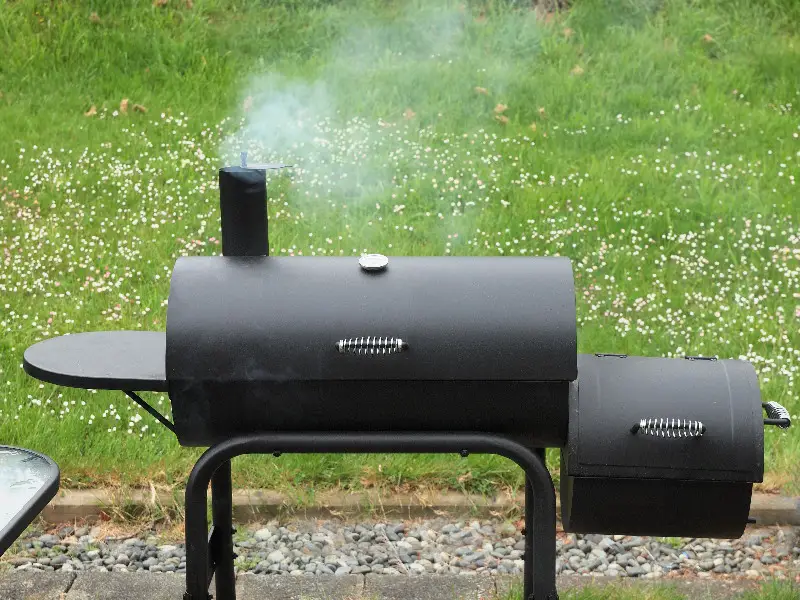
Smoking food has been around since man was able to harness fire. The ability to preserve meat by smoking it was a huge leap forward in our survival. Today we are not so worried about preserving meat by smoking it. We are looking for yummy smoked food.
Smoker basics
The best way I can describe smoking meat is slow cooking with a kiss of smoke. The basics of smoking are simple, burn wood, cook meat, lol. That being said, smokers are simple devices that are not hard to operate. Anyone can get good at using a smoker, and with enough practice, you can become a pitmaster.
Most smokers burn wood in a firebox or container to produce smoke and heat. A fire is built in the firebox using charcoal or hardwood like pecan, hickory, or mesquite. With the air dampener on the firebox open, the air will flow through the firebox and into the main chamber of the smoker.
Smoke and heat will fill the main chamber of the smoker and exit out the smokestack. The burning in the firebox is controlled by the amount of air you allow to enter the firebox through the dampener.
If you open the dampener completely, the fire will burn hotter and cleaner in your smoker, preventing bitter-tasting meat. The smoke and heat flow across the meat adding the smoke flavor and cooking it simultaneously.
Tip: try to keep the fire as small as you can and still maintain the cooking temperature, so you can leave the dampener fully open.
Finally, the smoke will exit the top of the smoker through the smokestack or chimney. Smokestacks, or the chimney, are usually on the top towards the back of your smoker, but each model will vary on the exact location.
Some smokestacks have a regulator lid or shut off. We recommend that you never use this and control your smoker solely by fire size and airflow dampener. We like to add a four-foot piece of small chimney pipe to your smoker’s chimney if the chimney is not part of the door assembly. You can direct the majority of the smoke from your smoker higher than doors and windows to your house, which is important.
Different types of smokers are controlled in different ways. The basics of heat and airflow remain the same regardless of the smoker type, but results can vary with each type of smoker. We are going to cover three main types of smokers, and how the air flows through each type.
Note: most links in this article are Amazon.com Affiliate links, see Affiliate Disclosure, thank you.
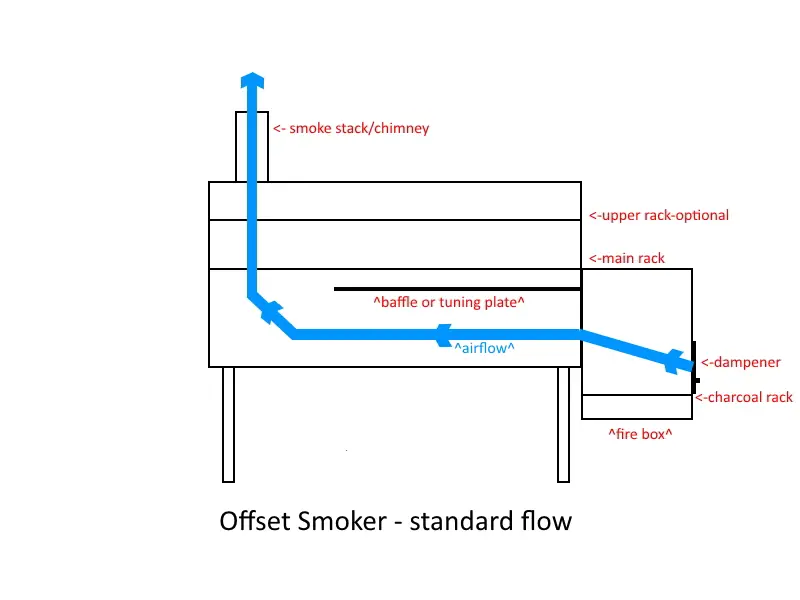
How does an offset smoker work?
In an offset smoker, the firebox is attached to the side of the main chamber, slightly offset lower than the main chamber. The lower offset of the firebox allows the smoke and heat to flow directly into the main chamber through a matching hole in the side of each compartment.
Some high-end offset smokers include a baffle or tuning plate to help spread the heat and smoke evenly throughout the main chamber. The blue line in the diagram shows the flow in a smoker with a baffle.
Without a baffle, in your smoker, the heat and smoke will go up as soon as it exits the firebox resulting in uneven heat and smoke. If your smoker doesn’t have a baffle, we recommend that you buy one or make one using some of our easy hacks in the modification section of this article.
After the smoke flows through the main chamber, it will exit through the smokestack.
Click here to read our Review of Char-Broil Offset Smoker American Gourmet Grill.
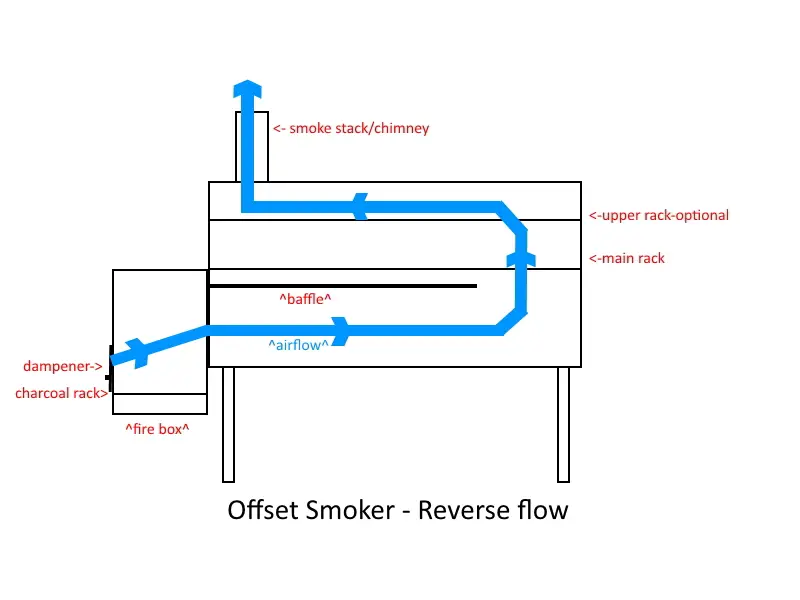
How does a reverse offset smoker work?
Airflow in a reverse offset smoker starts on the side of your firebox dampener control. Reverse flow smokers include a baffle for the smoke and heat to run across the bottom of the main chamber. Then the smoke and heat rise and reverses across the top of the main chamber until it exits the smokestack.
The blue line in the diagram shows the smoke and heat traveling across the bottom and then reversing to go back across the top of the main chamber. Keep in mind that the heat will be radiating throughout the smoker from the minute it enters the main chamber which is one factor in having a more even temperature.
The main benefit of the reverse offset smoker is even heat and smoke distribution. More even distribution can be a big deal when cooking a roast, pork butt, a large number of small items like chicken thighs or multiple racks of ribs.
An additional benefit is that the temperature will remain more consistent, reducing your cooking and yielding more consistent results. Reverse offset smokers are always more expensive than a standard offset smoker, but we think they are worth the extra cost.
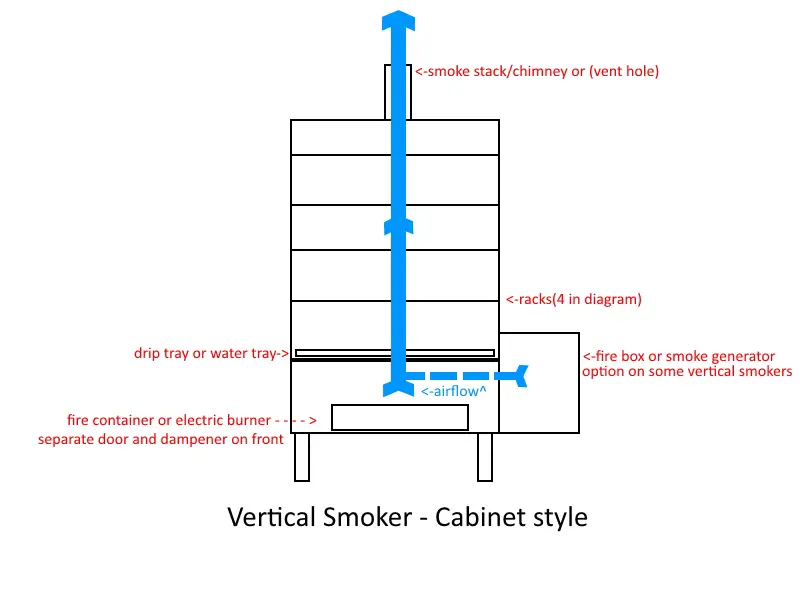
How does a vertical smoker work?
A vertical smoker (aka a cabinet smoker) has airflow from the bottom to the top. Many vertical smokers have a firebox or container with a door located at the bottom. Most electric wood chip smokers are vertical smokers.
The smoker generates smoke and heat at the bottom of the smoker. Smoke and heat rise past the meat and exit the cabinet from a vent or smokestack located near the top of the smoker.
There are a few vertical smokers that have fireboxes on the side, similar to an offset smoker. Other vertical smokers use an electric smoke generator attached to the side of the smoker. A smoke generator may use pellets or bisketts like the Bradley smoker.
Click here to check out our Review of the Bradley 4 Rack Electric Smoker.
How do pellet smokers work?
A pellet smoker can be either an offset or a vertical flow design. The smoker’s firebox is replaced with a pellet burner. Pellet burners are electric, which makes them very easy to use.
First, you load pellets into the pellet hopper. Next, you turn the burner on and adjust the setting. High-end pellet smokers have multiple controls so you can adjust time and temperature.
Top-of-the-line offset smoker models include Traeger Lil Tex Elite 22, which can do everything but flip your meat. There are only a few vertical pellet smokers available, and they don’t review well.
We were able to email a few verified buyers of the Masterbuilt MWS 340b, and they were happy with their purchase. The MWS 340b is a lower-priced smoker, so expect the smoker to reflect that.
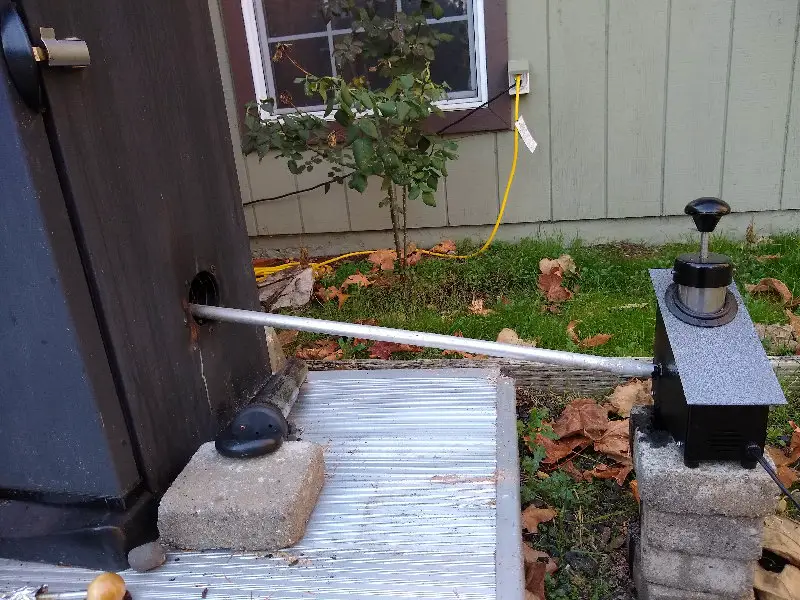
I use a Smokehouse pellet smoke generator for my Masterbuilt electric smoker. With the settings on the smoker, you can control the temperature and pump smoke into your smoker continuously. I slide a small piece of metal tubing inside my smoker’s fill tube and connected the other end to my smoke generator.
Summary
All smokers follow these basic airflow patterns. It is possible to design and build a smoker in almost any shape or size as long as you can move heat and smoke evenly across your meats. Smokers can come in any size from a small box to a smokehouse.
We still don’t recommend building your smoker unless you are just going for the cool factor. It is hard to beat an Oklahoma Joe’s Highland Reverse Flow Smoker(Click here to see on Amazon.com), this is a premium reverse flow smoker.
Oklahoma Joe’s smokers are quality products and include all the high-end smoker parts that you need to get started. The only items I would buy right away would be seal tape and two thermometers.
Top modifications for an offset smoker
There are some basic additions that every smoker can benefit from, but a budget offset smoker has a shortlist of modifications that can boost your performance.
Baffle
A baffle or a tuning plate is a must. A tuning plate is a heavy gauge metal plate with small holes on one end moving to larger holes on the other end. Your goal is to spread the heat and smoke evenly throughout your smoker.
You can buy a good tuning plate for your smoker, or you can make something to do the same job. I like to use a heavy-duty sheet pan and drill holes in it until I get the smoke to spread evenly. Also, a slight bend down the middle of the pan will let the grease pool in the corners for easy cleaning.
Finally, you can wrap old grill grates with heavy-duty aluminum foil, if you need to increase airflow poke a few holes in the foil. When the foil burns through or gets too greasy, then discard it and rewrap.
Thermometer
Thermometers are very important. Your smoker includes a thermometer on the top of your lid, but do you cook there, no! I would add two thermometers about five inches from each end and 3 inches above the cooking rack.
Start by using a small drill bit to make pilot holes. Then using a 3/8 inch drill bit, finish the holes and attach your thermometers. I don’t prefer to drill holes in my smoker, so I use a two probe meat thermometer.
I place one probe on top of the meat I am smoking and insert the second probe in the thickest part of my meat. By setting the first probe on top of the meat, I can keep track of the temperature inside the smoke.
Seal tape
Seal tape is great for maintaining good flow. Your biggest leak in a smoker is always the door or lid. If you buy a roll or two of seal tape, you can reduce or stop the leaks on your main chamber and your firebox. I always leave a small gap just to the right of the handle, so I have a place to run the wire for my two probe meat thermometer.
RTV silicon
RTV silicone sealer is great for all leaky joints. There are a lot of spots where you can leak like bolt holes, seams, and the connection point between the firebox and the main chamber. High-temperature silicone sealer is great for all the leaky spots.
I like the black RTV sealer for a smoker, but it is limited to 450 degrees. If you are concerned about going above 450 degrees, you can buy the red high-temperature RTV sealer with a rating of 650 degrees.
Fire basket
Fire baskets are another must-have for me. Well vented fires burn clean, and a fire basket can help with the airflow. The basket needs to be smaller than the opening of your firebox, which will leave space for the air to circular inside the firebox.
Another advantage is you can stack fresh wood or charcoal on top of your fire and not worry about it falling off the coals. I buy fire baskets on Amazon.com, but you can make one with non-galvanized expanded metal. Make a paper pattern of your basket and trace it on the metal with a sharpie. Fold the metal to form the basket and lace the corners with baling wire.
Firebox grate
I always place a grate at the bottom of my firebox for better airflow. You can buy some nice grates on Amazon.com, but I recycle old grates from my propane gas grill. I take my angle grinder and cut rusty old grates to fit perfectly in the bottom of my firebox from right to left.
Next, I take a second grate and cut it to fit from front to back. Fitting the racks in opposite directions will allow air to flow through and keep most of your coals on the racks.
Lid locks
Lid locks are a nice touch to keep your seal tight. With a small amount of pressure on your smoker lid, you can reduce or eliminate leaks. Mount lid locks on the edge of your smoker, and you will be able to clamp them down tight.
Small BBQ
My final modification might sound odd, but I like to light all my charcoal in a mini grill before adding it to my smoker. You can use a charcoal chimney, but you still need a spot to light your charcoal. Then you have to transfer your charcoal to your firebox. I use a clamming shovel to scoop the burning charcoal.
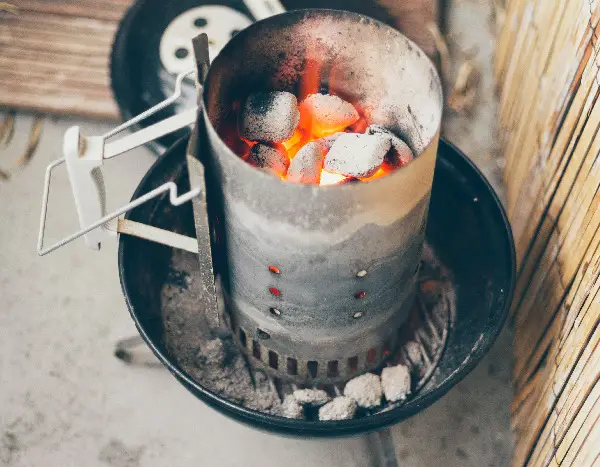
All the Modifications in this list can help your smoker perform better. You can make a cheap smoker perform well, or a great smoker can perform magic.
Enjoy!

